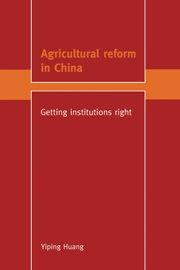Book contents
- Frontmatter
- Contents
- 1 List of figures
- 2 List of tables
- Acknowledgements
- 1 Getting markets to work in the countryside
- 2 Institutional distortions in pre-reform agriculture
- 3 Getting farmers back to work
- 4 Getting prices right
- 5 Adjustments in rural markets bring structural change
- 6 An agricultural economy without freedom to trade
- 7 China's agricultural policy choices
- 8 Chinese farmers can adapt
- 9 Getting reform right in agriculture
- Appendix: The China model
- References
- Index
6 - An agricultural economy without freedom to trade
Published online by Cambridge University Press: 18 June 2010
- Frontmatter
- Contents
- 1 List of figures
- 2 List of tables
- Acknowledgements
- 1 Getting markets to work in the countryside
- 2 Institutional distortions in pre-reform agriculture
- 3 Getting farmers back to work
- 4 Getting prices right
- 5 Adjustments in rural markets bring structural change
- 6 An agricultural economy without freedom to trade
- 7 China's agricultural policy choices
- 8 Chinese farmers can adapt
- 9 Getting reform right in agriculture
- Appendix: The China model
- References
- Index
Summary
The ‘third revolution’ and preparing for institutional change
Despite the successes of the 1985 reform, the decline in agricultural production that followed presented serious questions for China's overall economic development. At the same time as the government was implementing an austerity programme in the second half of the 1980s, it was stressing the importance of improving agricultural production, particularly of grain. Both agricultural investment and purchase prices were increased by large margins. Some planning measures to control both production and distribution were also resumed. Agricultural production recovered quickly in 1989 and 1990. Grain output reached 1984 levels (about 407 million tonnes) in 1989 and further increased by 9.5 per cent in 1990.
Good harvests, however, did not solve more fundamental problems: rising demand for grain was due to rapid increases in income and declining resources for grain production because of competition from other activities. This led to a continuous rise in domestic prices for grain and other agricultural products. The dilemma for the government was that on the one hand, given farmers’ increased bargaining power (see chapter 4), it had to increase its purchase prices to encourage grain production and secure procurement of a certain amount of grain, while on the other, every increase in purchase price had to be financed by a government subsidy that was directly transformed into a burden on the state budget.
To solve this policy dilemma, the government took a substantial step toward the liberalisation of marketing policies in urban areas at the beginning of the 1990s. Changes to policy marked a very important institutional innovation for Chinese agriculture, and was regarded by farmers as the ‘third revolution’ in the countryside.
- Type
- Chapter
- Information
- Agricultural Reform in ChinaGetting Institutions Right, pp. 96 - 117Publisher: Cambridge University PressPrint publication year: 1998

